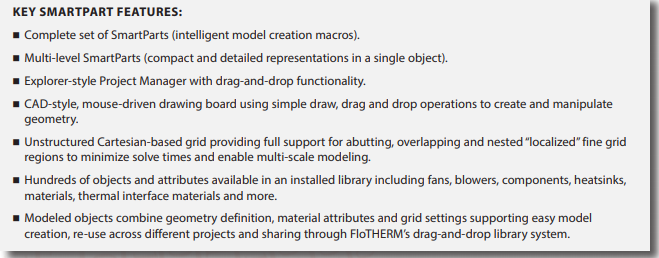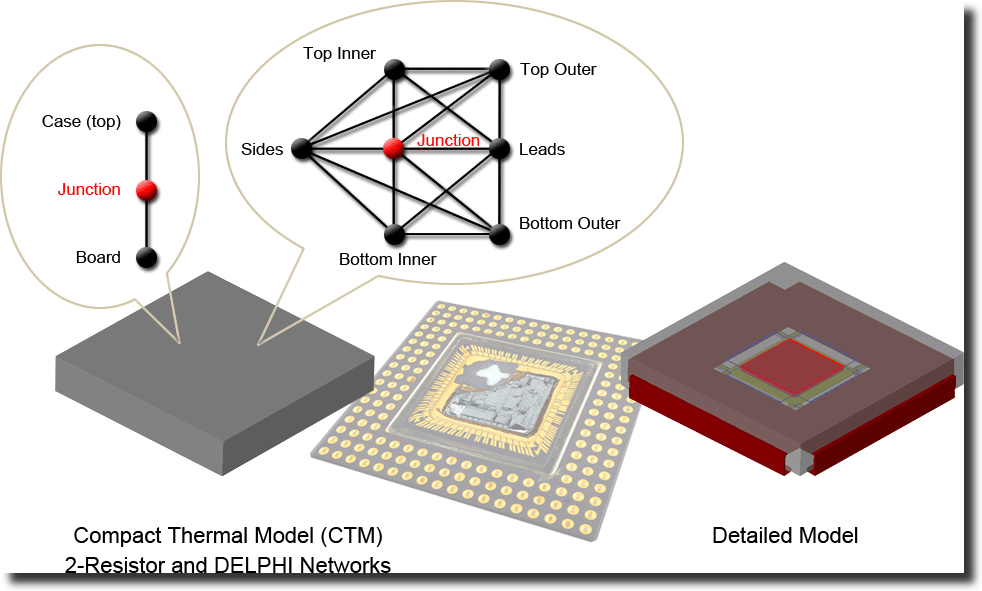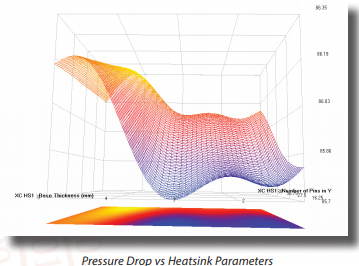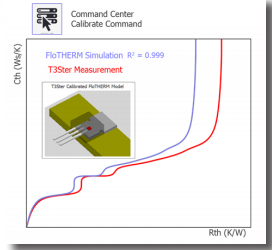Optimizing the Thermal Design of Electronics
Small and large companies alike rely on FloTHERM to perform their thermal-fluid analysis confident of the return on their investment. FloTHERM is powerful 3D simulation software for thermal design of electronic components and systems.
It enables engineers to create virtual models of electronic equipment, perform thermal analysis and test design modifications quickly and easily in the early stages of the design process well before any physical prototypes are built. FloTHERM uses advanced CFD (computational fluid dynamics) techniques to predict airflow, temperature and heat transfer in components, boards and complete systems.
Experience the benefits of using FloTHERM for electronic thermal design, that include:
■ Solving thermal problems before hardware is built;
■ Reducing design re-spins and product unit cost;
■ Improving reliability and overall engineering design; and
■ Significantly reducing time to market.
New features highlighted in version Flotherm 2210:
New features highlighted in version Flotherm 2021.2:
Model Creation

SmartParts®
FloTHERM features a comprehensive set of intelligent model creation macros (SmartParts) to allow a broad range of electronics
cooling applications to be built quickly and accurately. SmartParts are available for:
■ Heatsinks
■ Fans
■ Printed circuit boards
■ Thermo-electric coolers
■ Enclosures
■ Components
All SmartParts are aimed at streamlining model creation, minimizing solution times, and maximizing results accuracy.


Integration with MCAD & EDA
FloTHERM also features advanced, tight integration with MCAD and EDA (Electronics Design Automation) software. Data from Creo Parametric, Solidworks, CATIA and other major MCAD tools can be imported, simplified and converted into FloTHERM objects. Interfaces to Board Station, Xpedition PCB, Allegro and CR5000 extract board outline and component information for import into FloTHERM.
FloMCAD™ Bridge
FloMCAD Bridge enables parts and assemblies from Mechanical Computer Aided Design (MCAD) software (such as Creo Parametric, SolidWorks, CATIA, etc.) to be transferred easily and rapidly to FloTHERM for thermal analysis.
FloMCAD Bridge is more than just an interface program – it intelligently filters the geometrical data for a particular part or assembly and creates a simplified “thermal equivalent” for analysis purposes. This is critical because production quality MCAD solid models contain a vast amount of thermally insignificant geometric detail (fillets, small holes, chamfers, screw threads, etc.) that provide no accuracy benefit if included, but can significantly slow down the solution process. The ability of FloMCAD Bridge to defeature a part to match its thermal importance prior to translation into FloTHERM objects offers a massive improvement in the efficiency of the model creation workflow process.
The software also offers an intelligent and efficient voxelization algorithm for fast and general handling of geometric features of any shape and complexity.
FloEDA™ Bridge
FloEDA Bridge enables both import of detailed PCB designs as well as the ability to quickly sketch out conceptual layouts. Detailed PCB or BGA substrate designs can be imported in either the industry standard IDF format, or more detailed designs imported from our direct interfaces to the most common PCB design platforms. Full component layout, PCB stack-up and detailed descriptions of the metallic distribution on power, ground, signal, and dielectric layers are loaded. A unique method for the capturing of the metallic distribution provides a user controlled ability to define the level of resolution of the thermal conductivity
map. Block, 2-Resistor, DELPHI or ‘Detailed’ component modeling levels can be selected, including an automated ability to ‘swap-in’ higher fidelity models from an existing thermal model library. T3Ster-generated RC ladder compact thermal models can be directly read in, as can Network Assembly from FloTHERM PACK.
Conceptual layouts can be quickly sketched out, stack-ups imported from a user defined library, then transferred to FloTHERM for preliminary thermal simulation investigations.
FloTHERM® PACK
FloTHERM PACK is a web-based software program which produces reliable, accurate thermal models of IC packages and associated parts with the minimum of effort. Designed to fulfill the industry´s need for a rapid response to innovations in packaging design, FloTHERM PACK is a web-based application that
contains a parametrically-driven menu for each part type. To take advantage of FloTHERM PACK, you use your standard web browser to enter data describing the IC package you want to use. For example, if you want to build a model of a ball grid array (BGA) package, the typical data entry items would include: number of balls, substrate conductivity, die size, and substrate metal layer thickness and coverage.

Automation
FloXML
FloTHERM’s geometry and model data can be created by external scripts and utilities, for subsequent import into FloTHERM. The FloXML file format can hold any data that could be manually created in FloTHERM itself. Including objects, attributes, mesh and solver control settings. For standardized applications that would require repeated manual definition in the FloTHERM GUI, such FloXML generating scripts can drastically reduce the effort required for generation of ready-to-solve models and modeling data. A number of Microsoft Excel examples are supplied with the software that use VBA to create FloXML, automating common repetitive tasks.
FloSCRIPT
Actions performed in FloTHERM are logged to a FloSCRIPT file. This file can be re-played so as to repeat those actions in a FloTHERM session. This offers additional automation opportunities whereby changes to an existing model can be created by bespoke external scripts and utilities, further reducing what would otherwise be time-consuming manual model interventions.

Meshing
FloTHERM uses a locally-unstructured Cartesian-based mesh – the most stable and numerically efficient type of mesh available. The ability to localize is also included for finer resolution where it is needed, minimizing solution time.
Mesh in FloTHERM is associated with SmartParts and is generated as part of the model assembly process with refinement under user control. This methodology is intuitive and straightforward enabling engineers to focus on design rather than analysis.
Meshing is instantaneous and reliable in FloTHERM, as compared to traditional tools that require significant time and expertise to master. Finally, FloTHERM is the only analysis software with object-associated mesh that eliminates re-meshing for each model modification.
Solver
For over 25+ years, the FloTHERM solver has specifically addressed electronics cooling applications. The solver produces the most accurate results possible and the fastest solution time per grid cell. Massive disparities in geometric length scales are resolved using the unique ‘localized-grid’ technique which allows for integrally matched, nested, non-conformal grid interfaces between different parts of the solution domain. The conjugate nature of heat-transfer within electronic systems is concurrently solved using a preconditioned conjugate residual solver together with a flexible cycle multi-grid solution technique. Pragmatic, unique and accurate solution termination criteria produce useful results in engineering, not academic time scales.


Transient Analysis
The powerful transient analysis capabilities in FloTHERM also allow for prediction of a number of different transient behaviors. Time dependent power dissipation in components can be defined via .csv import of power versus time data. An accurate prediction of the thermal response of the component temperature, in time, may then be produced without the conservative assumption of constant “steady state” power consumption.
Transient thermostatic control modeling can be performed via the ability to have a model input vary, not only as a function of time, but also optionally as a function of a monitored temperature during the transient solution. This allows for temperature controlled fans to be considered as well as determination of power derating and thermal mitigation strategies.

Post-Processing
The FloTHERM visualization toolset is developed specifically to maximize productivity for design of electronics cooling. Fully rendered models, 3D flow animation and tools for dynamic manipulation of temperature and flow results, enable engineers to pinpoint thermal issues and visualize design improvements quickly and effectively. Texture mapping and AVI output enables
communication of thermal-design concepts with non-technical colleagues.
PARAMETRIC ANALYSIS AND OPTIMIZATION
SmartPart-based modeling and structured Cartesian grid enable Design of Experiments technology to be applied to a FloTHERM model. Design of Experiments (DoE) is a structured method for determining the relationship between design parameters (e.g. number of heatsink fins, location of vents, etc.) and results (component temperatures, fan flow rate, etc.). FloTHERM’s Design of Experiments implementation efficiently explores the design space by building and solving variants of the initial model. This
provides critical information regarding the sensitivity of the thermal results to changes in the design parameters while minimizing the number of simulations to be solved and serves as the foundation of the powerful response surface and sequential optimization design tools. To assist with the solution of the Design of Experiment cases, the user may optionally use a distributed network of computers using ‘Volunteer’ solution technology.
FloTHERM extends this concept by computing response surfaces for all results of interest. Response surfaces are mathematical equations derived from the DoE results that estimate the thermal solution anywhere in the design space instantaneously. The user may interact with the constructed Response Surfaces with real-time 2D and 3D plots that have slider bars to control the design parameter values. Mathematical optimization of a user defined cost function is fully supported with the Response Surfaces as well, enabling the optimal solution to be estimated without solving additional cases.
Automatic sequential optimization of the cost function can be performed as well. This gradient based approach will build and solve additional variants of the initial model to explicitly determine and confirm what the optimal thermal solution is. Sequential optimization is able to understand design constraints (such as maximum component temperatures) and incorporate them into the presented optimal configuration.
T3Ster Detailed Model Calibration
Automatic calibration of detailed thermal models against
T3Ster-generated experimental results ensures a near-exact
match to the package’s structure function, ensuring accurate
temperature vs. time response irrespective of the length of the
power pulse – critical for use case analysis and reliability
prediction.


